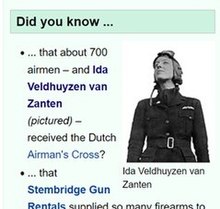Wikipedia:Wikipedia Signpost/2021-11-29/Serendipity
Did you know?

There were only a few hundred women pilots in World War II. Yet Wikipedia recently mixed up the images of two women pilots from that period. The image of Veronica Volkersz (née Innes) was featured prominently on the English Wikipedia main page on 19 November 2021, to illustrate the DYK ("Did you know?") item about Dutch pilot Ida Veldhuyzen van Zanten.
This was the complete text of the DYK hook: "Did you know … that about 700 airmen – and Ida Veldhuyzen van Zanten (pictured) – received the Dutch Airman's Cross?" Pictured was a woman pilot. So far, so good. It was a pity though that the woman in the photo was not Ida Veldhuyzen van Zanten, but Veronica Volkersz.
First woman flying a fighter yet

Love was to blame, of course. The photo was taken from the Dutch National Archives, which had a rather complicated text accompanying the photo, speaking more about Ida Veldhuyzen van Zanten than about the actual pilot in the photo, Veronica Volkersz. Veronica, born Veronica May Innes in Chesterton, April 17, 1917, was a former beauty queen who joined the Air Transport Auxiliary (ATA) as a Second Officer in March 1941. We know this because of the book that Veronica Volkersz wrote about that period (The Sky and I, 1956) and because of her RAF logbooks 1939–1965 (currently for sale online at £9,000).[1]

Veronica married Dutch pilot Gerard Volkersz in Chelsea in 1942, and thus acquired Dutch nationality – hence the mix-up in the Dutch archives. ATA pilots like Veronica were tasked with ferrying aircraft between airfields, but she did far more. Her first solo flight in a Spitfire was in 1941, and she flew in a few dozen types of aircrafts. She was in fact the first woman ever to pilot a Gloster Meteor EE386, a jet fighter. Volkersz flew until 1965. She died in Cambridge, Dec. 13, 2000. According to AbeBooks: "The entry on her Death Certificate describes her occupation thus: 'Aviator (retired)'." Indeed, this woman needs a Wiki article a.s.a.p.
Mistakes and metadata

Back to Ida Veldhuyzen van Zanten – who rightly received the Dutch Airman's Cross in 1947, and still is the only woman to have received this distinction. Pictures of her are quite rare, but I recently found some images to illustrate her Wikipedia article, helped by a family member and the Dutch National Archives. About 400,000 photographs from this archive, Nationaal Archief, were transferred to Wikimedia Commons in the last decade.[2]
All metadata contain mistakes. That's only natural, and Wikipedia editors were not the first to be tripped up here. They were in good company: the Dutch Ministry of Defence used the same wrong photo of Ida in its magazine De Vliegende Hollander (Flying Dutchman) in 2015.[3]
Wikipedia can learn from the mistake made with this photo in DYK. Never take information for granted, not even metadata from National Archives. In this case the (admittedly unclear) source, in which two names were mentioned, should have been a clear warning sign. Moreover: the original of the cropped photo of Veronica Volkersz was already in Commons – with correct attribution.



Discuss this story
Andrew Davidson started a stub about Volkerz. I was about to beat him by 3 hours :-) but I decided to step aside :-) In doing research I run into some group photos and here is a caption: ATA women pilots at No.15 Ferry Pool, Hamble, in 1943. Here Mary is with friends, standing second right of the picture. In the front row, left to right, are: Rita Baines, Rosemary Bannister, Faith Bennett, Rosemary Rees, Margot Gore, Veronica Volkersz, Jackie Sorour, Mary Wilkins, Margaret Frost. In the back row, again left to right, are: Pam Tulk-Hart, Joy Gough, Sylvia Edwards, Monique Agazarian and Helen Kerly
It is nice to see that the majority of these ladies got their article, but some are still missing. Anyone? "Women in Red"? Loew Galitz (talk) 18:03, 30 November 2021 (UTC)[reply]
I don't really understand the applicability, given the discussion is over one recent case of a man with the wrong image, and one recent case of a woman with the wrong image. (So, what makes this a problem specific to women subjects or editors?)Two errors is not worth starting witch-hunts over, though there is validity in pursuing discussion about a corrections section/process. I agree with comments in favour of one above, but would like to point out that there's only so much use it could have—newspapers really have them for legal reasons, and as a way to cordon off that pesky matter of the truth when it conflicts with the newspaper's propaganda (100 people read the lie on the front page and 5 read the tiny correction a week later). — Bilorv (talk) 00:38, 3 December 2021 (UTC)[reply]